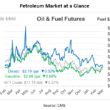The Australian Competition & Consumer Commission (ACCC) yesterday approved the bid by Bauer Media Australia to acquire its nearest rival, Pacific Magazines in a A$46.6m deal which is expected to complete by April 9.
The fact that the Coronavirus has intervened means Bauer (which is contractually bound to complete the acquisition) is paying much more than Pacific is now worth. It, presumably, means more of the closures and redundancies that had once worried ACCC.
The Sydney-based subsidiary of the privately-owned German magazines-radio group, is buying Pacific Magazines from the troubled broadcaster Seven West Media, controlled by Kerry Stokes, for which the deal has now turned into a rare stroke of luck. The price (A$40m cash and $6.6m of advertising in Bauer magazines), was said to be 5.5 x EBITDA for 2019. It is now believed that Pacific would be only marginally profitable in 2020. Phew.
Pacific’s key brands are Better Homes & Gardens, New Idea, Who, Marie Claire, and That’s Life!, all of which compete directly with Bauer magazines. The combined company will be the completely dominant Aussie publisher with 50 brands and an estimated market share of some 60%.
The deal had been thrown into doubt by objections, including from Getty Images (principal supplier of photography to both publishers), and by the wavering of the UK Competitions & Markets Authority over Future Plc’s parallel £140m bid for TI Media. In the event, both deals combining the two leading magazine publishers, respectively in the UK and Australia, have now been approved (Future’s is subject to some small divestments). The approvals underline how relatively unimportant magazines have become in an advertising and lifestyle market dominated by Facebook and Google. Nobody worries about magazine monopolies anymore.
The Australian deal had briefly been thrown into confusion by the revelation that, having negotiated the acquisition of Pacfic, Bauer was in “advanced negotiations” to sell the enlarged company to Mercury Capital, of Sydney for A$150m. Those talks were then said to have been discontinued.
Magazines have long punched above their weight in Australia. During the 1990s, the country’s largest publisher (ACP, now Bauer) sometimes made higher profits than its UK counterpart, the former IPC Media. ACP magazines Woman’s Day and The Australian Women’s Weekly each achieved 1m copy sales in a market of only 8m women. Its Cosmopolitan had higher profit margins than any of the US magazine’s 50+ worldwide editions.
Even when digital disruption started to squeeze magazine advertising and sales across the world, ACP Magazines had seemed able to keep growing at the expense of competitors – like Pacific. Two key developments changed everything.
First was the 2005 death of the legendary Kerry Packer whose deal-making had hugely expanded the TV and magazines group he inherited from his father 30 years before. He had transformed his media and casino business during the last quarter of the twentieth century with winning bets on TV sports rights, digital media – and magazines.
His son James shocked family members and shareholders alike by selling his PBL Media inheritance (ACP Magazines and Channel Nine TV) within 12 months of his father’s death to CVC private equity. The A$5.3bn deal proved to be an inspired move at a top-of-the-market price. CVC quickly lost its equity in what proved to be a disastrous deal.
Then, seven years later – after cuts, closures and a collapse of confidence in the Aussie magazine market and its long-time leader – Bauer bought ACP Magazines for A$500m in 2012. Although ACP was no longer making the A$250m+ profits of its heyday, the family-owned German publisher bought the forecasts of A$100m. In the event, it got nothing like that. By 2019, the Sydney-based company was making EBITDA of some A$35m, almost one-third from its New Zealand subsidiary.
The whole AsiaPacific venture has been a nightmare for the so-private company that (although it moved gutsily into the US even before launching in the UK in the 1980s) had never operated so far from its Hamburg base.
No fewer than six CEOs in nine years and a host of magazine closures (including Cleo, Top Gear, Zoo, Madison, Grazia, Burke’s Backyard, BBC Good Food, FHM and Cosmopolitan) tell the story of a deal that went sour long ago. Tellingly (and uncharacteristically), the 2012 Sydney deal had not been something Bauer had even contemplated just a year before they did it. They had been prompted by their own London-based executives of the former EMAP magazines and radio business which they had acquired for £1.1bn in 2007.
Their positive experience in the UK had spoiled them. Even though some of the largest magazines like Heat and FHM were sliding by the time Bauer took over, its special interest magazines were strong. More than that, the strong UK radio business was growing fast and has since become the motivation for Bauer’s broadcasting expansion in Continental Europe and Scandinavia. Radio and music is now the €3bn-revenue Bauer’s fastest-growing business in a group of 600 magazine titles, 400 digital brands and more than 100 broadcasters.
We speculated last year that the proposed Pacific deal was a precursor to a Bauer exit from Australia, before a parallel negotiation with private equity became known. Bauer will want to get back to selling its troublesome Aussie subsidiary. Inevitably, there may be a pause for the Coronavirus – unless Mercury Capital dusts off its documents and does a deal – at a bargain price.
Having appointed her newest CEO Brendon Hill (promoted from its New Zealand subsidiary), chair Yvonne Bauer will be keen to close the Australian chapter in her family’s media story, after racking up some $650m of losses and investment. Getting stuck paying way too much for Pacific is just one of those things.




